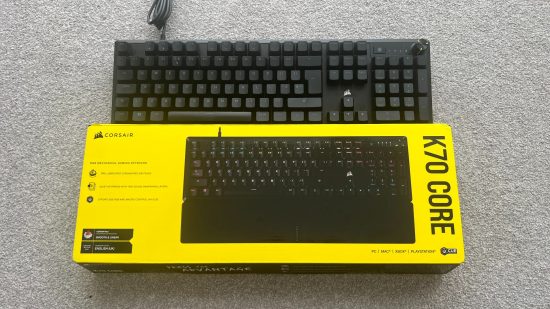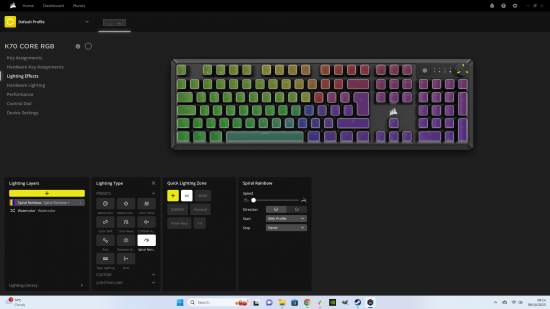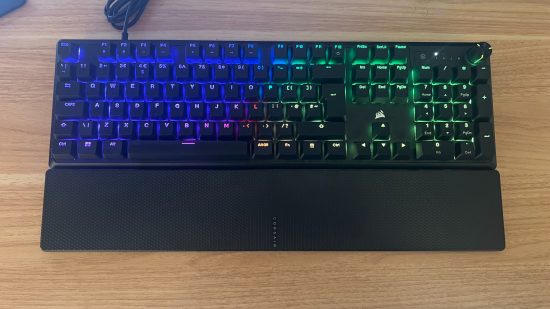Our Verdict
A brilliant entry-level gaming keyboard, the Corsair K70 Core is missing a lot of what it takes to be elite, but this stripped-back nature also works in it's favor, creating a streamlined experience with a focus on performance.
The hierarchy of mechanical gaming keyboards is stuffed full of elaborate feature-packed RGB monstrosities, but the Corsair K70 Core takes a step back and puts true usability above all else and does so to great effect.
Corsair is ensuring that even some of the best gaming keyboards can go back to basics and strip away a lot of niceties and features that the average gamer simply won’t miss. I enjoyed my time testing the K70 Core, but it’s clear that this is only intended to be an entry-level keyboard that one might use before upgrading to something flashier.
Pros
- Fantastic price compared to the market
- Great build quality
- RGB customization has a huge depth
Cons
- Switches are basic when compared to Optical
- No control over actuation points
| Corsair K70 Core Specs | |
| Connectivity | Wired |
| Key switch type | Corsair Red linear |
| Media controls | Yes, with a reprogrammable dial |
| Number of keys | 105 |
| N-key rollover support | Yes |
| Onboard profile storage | 5 |
| Palm rest | Included |
| Dimensions | 448 L x 153 W x 35.4 H (mm) |
| Weight | 2.059lbs |

Corsair K70 Core features
Practically speaking, I’ve never taken to using the media control dials on a keyboard, especially when I could just create or use a key shortcut instead, but the Corsair K70 Core has converted me. The media dial isn’t only for volume control; with the quick hammering of FN + F12, you can switch between five feature profiles. These allow you to; control the volume of your PC, alter the brightness of the backlights, vertically or horizontally scroll, and zoom in and out. I found that each setting was situationally useful, and the ease of switching between modes made it all that much easier. The K70 Core also comes pre-set with nine standard shortcuts but using iCue, Corsair’s software for managing its peripherals, I was able to set up as many keyboard shortcuts as I desired. It’s a simple process that is entirely tutorialized within iCue, so if this is your first time getting to grips with a modern keyboard, it makes sure you know exactly what to do.
The iCue software is also how you’ll edit the RGB lighting on the Corsair K70 Core. There are endless options and even some decent pre-loaded settings if you’re not overly keen to get deep with your lighting layout. In general, iCue does a fantastic job of walking you through every product you connect to it with clear tutorials. You can skip these if you’re confident that you know what you’re doing, but I was more than happy to have everything laid out in front of me to give me confidence that I wasn’t missing anything. It’s possible to store up to five profiles on the K70 core, whereas, within iCue, there is no limit.
Corsair K70 Core design
Visually, the K70 Core is nothing too exciting. A standard black full-size keyboard with a convenient, and textured, magnetic palm rest. It’s plastic, so no need to worry about the cold shock of metal when you first start using it, but more importantly, it sits perfectly for my hands and does offer an additional level of comfort while typing. The matte coating on the keys also does a great job of not allowing dirt to transfer onto the keyboard.
The build quality of the K70 Core is also commendable. It’s sturdy and never feels cheap, instead, it feels very dense, coming in at 820g without the palm rest. Key removal is simple, but no tool is provided in the box which is a shame. As a wired-only keyboard, it’s notable that a simple plastic cable is used for the USB 3.0 connection, rather than a braided option. This can be quite annoying if you’re as strict on cable management as I am on your desk, but it’s not the end of the world.
The K70 Coreuses Corsair’sown Red linear mechanical switches which have a 1.9mm actuation distance. This aids in their responsiveness, but there are a lot of other options on the market with a shorter distance as standard, or come with the ability to customize this distance to suit your preference. Personally, I had no issues with switch actuation during my testing.
Corsair K70 Core performance
Corsair has really gone overboard to ensure that the K70 Core is a terrific keyboard to use daily. The red linear switches are super-responsive but took some getting used to, largely due to the two layers of sound-dampening materials. I’m not someone who wants my mechanical keyboard to be as loud and obnoxious as possible, so Corsair ensuring the K70 is a quiet keyboard but not sacrificing keystroke responsiveness is a big win in my book.
Gaming on the K70 Core is a little different, though. You’re not always able to gain a visual representation of a keystroke in a game if the key is unbound, but if it is, then you can really mess up clutch moments in games. Sometimes the keyboard is too responsive, leading to these accidental activations. The best example of this I can think of is in CS2, where I was using Q to switch between my most recent weapons. There would be times when the K70 Core was registering a double press, which landed me in situations where I had the wrong weapon out at the wrong time. This wasn’t a frequent incident by any means, but what I believed to be a problem with me adjusting to the keyboard, was proven otherwise by a little bit of isolated testing.

Corsair K70 Core where to buy and price
The Corsair K70 Core is available for $99.99 / £89.99 and can be purchased directly from the Corsair website.
We feel this is a great price point for the K70 Core, especially as it’s positioned well to be an entry-level gaming keyboard. It also has full compatibility with consoles and is guaranteed for 70 million keystrokes, so your investment won’t be at risk of falling flat with the K70 Core. You’ll struggle to find true mechanical keyboards, with RGB and added features, from a reputable brand, for under the $100 price point.
Should you buy the Corsair K70 Core?
There are plenty of other products out there that will cost a lot more than the K70 Core, but fail to offer a better base performance. Sometimes, you need to ignore some of the buzzwords and understand that a keyboard, at its core, is for typing. Corsair not only knows this, but they built the K70 Core with this in mind.
Yes, there are a few bells and whistles added on to create value, but the K70 Core is a great mechanical keyboard that’s a pleasure to use. It’s also priced just right, with no risk of diminished returns where you pay for features you’re unlikely to use or benefit from.
In a market where everyone is trying to stuff unnecessary features that offer little benefit, Corsair positions the K70 Core as an everyday mechanical laptop that is a joy to use and keeps things simple.
If the Corsair K70 Core isn’t for you
The K70 Core is a great entry-level keyboard, but if you need something wireless, we suggest opting for the Logitech G915. It’s got fantastic performance and a beautiful design that doesn’t overstimulate you thanks to muted RGB.
If you’re fine with wired but are just chasing performance, the Corsair K100 RGB offers optical switches for improved responsiveness and a unique backlighting style that’s easy on the eye.
Verdict
The Corsair K70 Core does an incredible job of placing functionality first, and adding features carefully to ensure using it doesn’t become a chore to use, or over bloated nightmare. That being said, despite its performance, there are a lot of better options on the market if you’re looking for a keyboard to potentially offer you an edge in games, or one that you can fully customize for your style of play.
